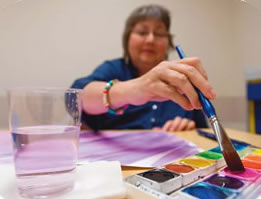Creative Control
Art therapy offers artistic freedom and empowerment to people with cancer

Linda Westervelt enjoys making her own choices. Too often as a cancer patient, however, she has to leave decisions about her treatment and health in the hands of her doctors.
But when Westervelt participates in the art therapy program at the University of Michigan Rogel Cancer Center, she's in control.
"It's nice to make decisions in art therapy, and it's a good outlet for that," Westervelt says. "There are a lot of things going on outside of a patient's control, and although my doctors give me choices once in a while, they're the ones who know the right way. Art therapy is a great environment to make my own decisions."
U-M offers one-on-one art therapy sessions for cancer patients and survivors with an art therapist. The sessions are designed to help patients increase self-awareness and cope with symptoms, stress and traumatic experiences.
The dynamic of these sessions allows patients control they sometimes lack in other aspects of their lives. Sessions begin with a discussion about the patient's health and well-being, and from there, the art therapist helps direct the patient toward an artistic avenue of their choice.
Patients control the session. They're pretty self-directed. Sometimes patients say, 'I know that I have been holding in a lot of feelings, and I'm trying to stay strong, but for my health I need to let some things go. I've never painted before, and I want to know what it's like.'"
Westervelt says channeling her thoughts and feelings through various art projects can be a relaxing distraction.
"It gives me a real lift," she says. "It's very nice to have an outlet for creativity and thinking about something. Making something of my own gives me a really satisfying feeling."
Art Therapy offers patients the opportunity to not only paint, but to use other art supplies such as colored pencils, pastels and pens, as well as craft items like wooden picture frames, bird houses, ceramic tiles and paper for origami. There is also an "art studio on wheels" -- a cart filled to the brim with various arts and crafts supplies -- used during one-on-one sessions.
Although patients who have an artistic background tend to choose art therapy from the Complementary Therapies Program, patients do not need any art experience to participate.
The sessions can help patients increase their self-awareness and alleviate mental and physical pain. Patients sometimes begin a session saying their pain is at an 8 or 9 out of 10. But by the end of the session, things are different.
Westervelt says: "I feel so much better," she says. "It's like I've done something worthwhile and useful to me. I believe it's improving my health, and I feel like I can cope better."
